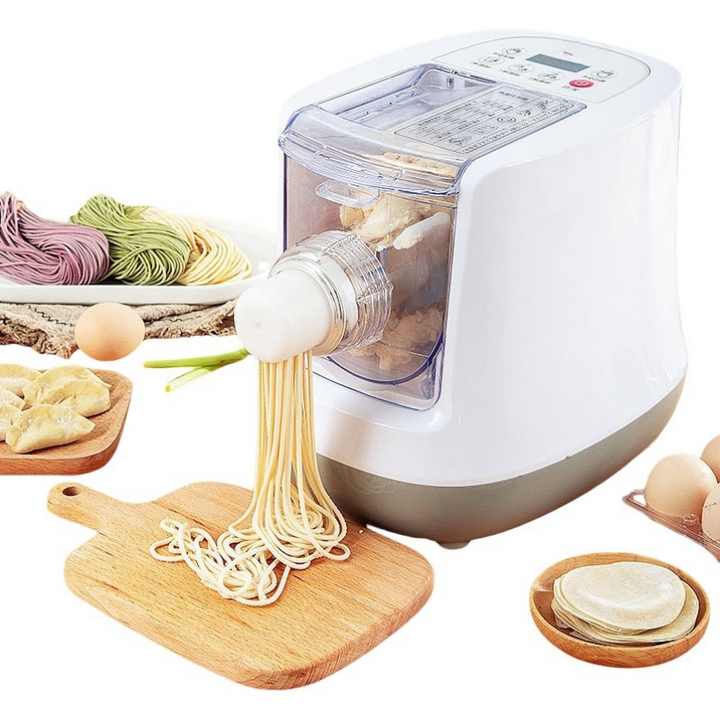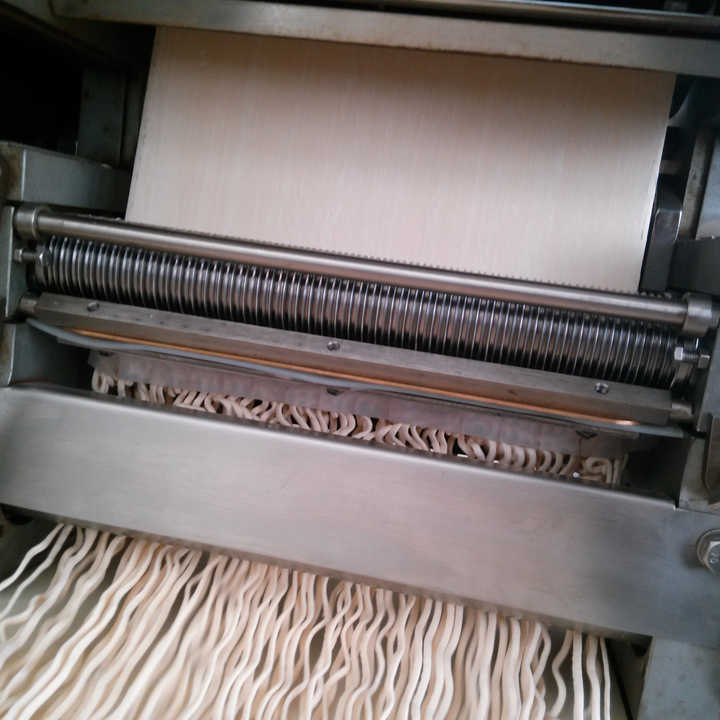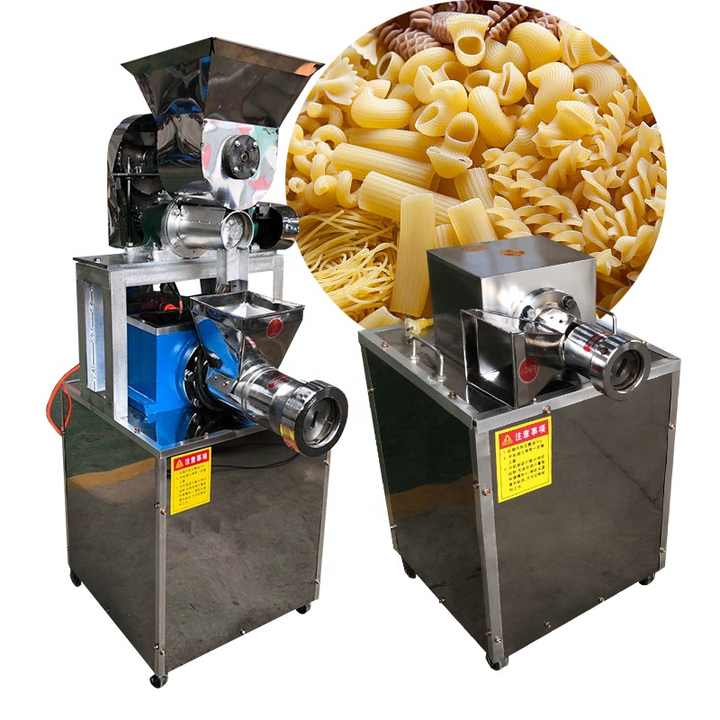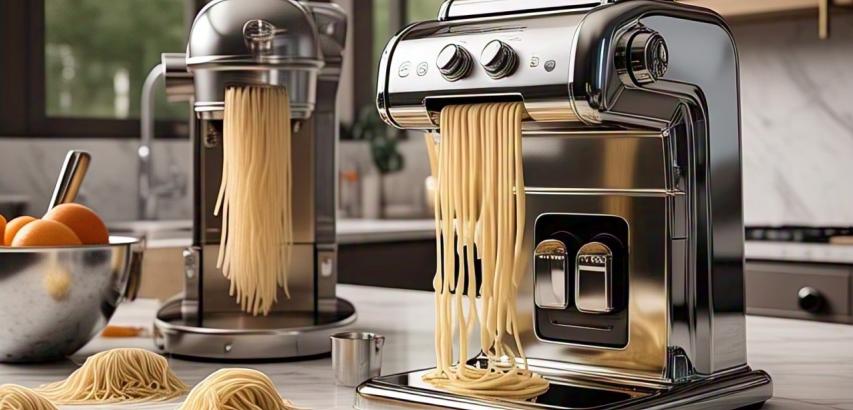Noodles and pasta makers are specialized kitchen appliances designed to transform simple ingredients – primarily flour, eggs, and water – into fresh, homemade noodles or pasta. They offer a rewarding alternative to store-bought dried varieties, allowing for complete control over ingredients, texture, and shape.
Types of Makers:
Manual Pasta Rollers & Cutters (Most Common Type):
How they work: These typically consist of two rollers (adjustable for thickness) and attachable cutting dies (for shapes like fettuccine, spaghetti, lasagna).
Process: You feed a rested ball of dough through the rollers repeatedly, folding and thinning it into sheets. The sheet is then fed through the chosen cutting attachment.
Pros: Affordable, compact, offers great control over thickness, relatively easy to clean, provides a hands-on experience. Great for traditional Italian pasta shapes.
Cons: Requires manual cranking (can be tiring for large batches), needs counter space or clamping.
Electric Pasta Extruders:
How they work: These machines mix the dough internally (often requiring pre-mixed dough) and force it through a die under pressure to create specific shapes (like penne, rigatoni, macaroni, or even some Asian-style noodles).
Pros: Easier on the hands (no cranking), can create complex hollow shapes impossible with rollers, often includes mixing capability.
Cons: More expensive, larger and heavier, limited to extruded shapes (no sheets for ravioli/lasagna), dies can be expensive and harder to clean thoroughly, dough consistency is more critical.
Stand Mixer Attachments:
How they work: Roller and cutter attachments designed for popular stand mixers (like KitchenAid).
Pros: Utilizes an existing appliance motor, saves counter space (if mixer is out), powerful and consistent rolling/cutting.
Cons: Requires owning a compatible stand mixer, attachments are still a significant investment.
Key Benefits of Using a Maker:
Superior Freshness & Taste: Homemade pasta/noodles have a distinctly delicate texture and richer flavor that's hard to match with dried versions.
Ingredient Control: Use high-quality flour (semolina, whole wheat), farm-fresh eggs, or create gluten-free, vegan, or vegetable-infused doughs (spinach, beetroot, squid ink).
Customization: Choose the exact thickness and width for your dish. Make unique shapes or experiment with flavors.
Texture: Achieve the perfect "al dente" bite tailored to your preference.
Satisfaction: The process is rewarding and connects you to the culinary tradition. Impress family and friends!
Versatility: While often called "pasta makers," most roller/cutter types excel at making Asian-style noodles too (ramen, udon, soba, wonton wrappers) with the right flour and dough hydration.
Important Considerations & Drawbacks:
Time & Effort: Making pasta from scratch is significantly more time-consuming than opening a box. It involves mixing, resting, rolling, cutting, and cooking.
Learning Curve: Achieving the perfect dough consistency (hydration is key!) and mastering the rolling/cutting process takes practice.
Cleanup: Machines, especially extruders with intricate dies, require careful cleaning to prevent dried dough buildup.
Storage: Fresh pasta cooks quickly but doesn't store long-term like dried pasta without drying it further or freezing it.
Cost: While manual rollers are affordable, electric extruders and stand mixer attachments are a significant investment.
Space: Requires storage space for the machine and its attachments.
Choosing the Right Maker:
Manual Roller/Cutter: Best for beginners and those who want versatility (sheets + cuts), affordability, and a hands-on approach. Ideal for Italian pasta and many noodle types.
Electric Extruder: Best for those wanting hollow shapes (rigatoni, macaroni) and who prioritize convenience over manual effort. Less versatile for sheets or wide noodles.
Stand Mixer Attachment: Best for owners of compatible mixers who want motorized rolling/cutting without buying a separate appliance.
Getting Started Tips:
Start Simple: Begin with a basic egg dough for fettuccine or spaghetti.
Follow Recipes: Pay close attention to flour-to-liquid ratios. Dough consistency is crucial.
Rest the Dough: Allow the mixed dough to rest (covered) for at least 30 minutes. This relaxes the gluten, making rolling easier.
Flour Generously: Prevent sticking by dusting the dough and rollers with flour (semolina works great too) as you work. Avoid over-flouring the dough itself.
Roll Gradually: Start on the widest setting and gradually reduce thickness, passing the dough through each setting multiple times if needed. Fold and rotate the dough sheet.
Dry Briefly: Let cut noodles/pasta air-dry for 10-20 minutes on a rack or floured surface before cooking to prevent clumping (unless making filled pasta immediately).
Cook Immediately: Fresh pasta cooks very quickly (often 1-3 minutes) in well-salted boiling water.
Clean Thoroughly: Disassemble and clean according to manufacturer instructions immediately after use. Never soak metal parts.
Noodles and pasta makers unlock the door to a world of fresh, flavorful, and customizable culinary creations. While they require time, effort, and practice, the superior quality and satisfaction of crafting your own pasta or noodles from scratch make them a worthwhile investment for passionate home cooks. Whether you choose a simple manual roller or a sophisticated electric extruder, the delicious results are a true taste of accomplishment.
 |  |  |
Buy Noodles and Pasta Maker - Amazon
 |  |  |
